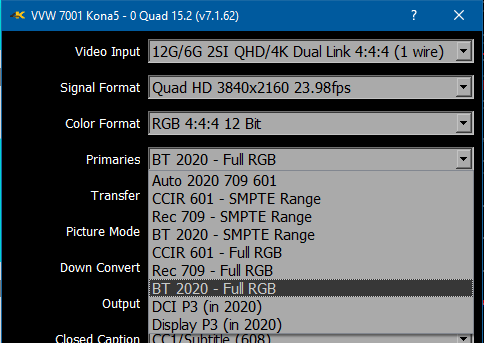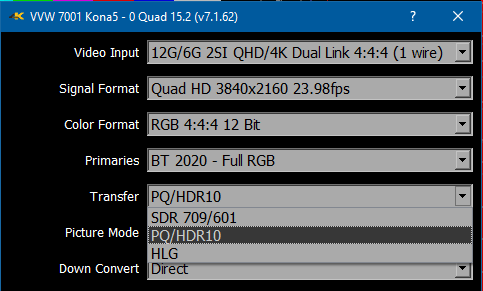 4KScope, HDRScope, and NetXScope support 8, 10, and 12 bit color in both YCbCr 4:2:2 and RGB 4:4:4 modes. Correct measurement of signals requires the correct setup of the bit depth, color format, primaries and transfer mode of the signal you are measuring. This article covers the most common configurations.
4KScope, HDRScope, and NetXScope support 8, 10, and 12 bit color in both YCbCr 4:2:2 and RGB 4:4:4 modes. Correct measurement of signals requires the correct setup of the bit depth, color format, primaries and transfer mode of the signal you are measuring. This article covers the most common configurations.
Input Color - YCbCr (YUV) and RGB
Once the signal format is set, the next most important is the overall color format. 4KScope, HDRScope, and NetXScope support YCbCr (broadcast) at 8 and 10 bits, and RGB (post production) at 8, 10 and 12 bits (depending on hardware). For most SDI and HDMI signals you will want to be in YCbCr 10 bit, as this is by far the most common format. Even if the signal source is 8 bit, it will still work in 10 bit. If you are monitoring a high end post system (Nucoda, Assimilate, Autodesk, Resolve, etc.) then the input may be a 4:4:4 RGB, also known as dual link, input. In this case, it will be either a 10 bit or 12 bit signal. As 10 bit will work for both 10 and 12 source, if the image is incorrect in 12 but correct in 10, then it is likely a 10 bit source.

Primaries
4KScope, HDRScope, and NetXScope support a wide variety of primaries. These describe the color space being used in terms of chrominance and saturation. As a general rule of thumb, the following are the standard primaries for various signal types:
- SD - CCIR 601
- HD - Rec 709
- QHD/4K - BT 2020 (but may be Rec 709)
- QHD/4K Post - P3/BT 2020/709 (but may be Full Range RGB)
While it is possible to mix these (e.g. send 4K with CCIR 601 primaries), it would be very uncommon. The trickiest part of this configuration can be the SMPTE Video Range vs. Full Range RGB, when running in RGB modes. When producing RGB over SDI/HDMI/IP, the creation software can choose to make the 0% color (standard black) and the 100% color (standard white) to be the 0 value and 4095/1023 value. In these cases it is using the 'Full' range of the RGB to describe the standard color range. As normal video has a range that allows brighter than white and darker than black values, it is very common to duplicate this functionality in RGB space, making standard black 64 and standard white 3760/940. This is known as SMPTE or Video Range. If the signal is using SMPTE or FULL, and the scope software is set to the opposite, then the graticules will not line up properly. These settings must match.

When using RGB Full, it is also important that the RGB Waveform Scope has its 'Full Scale' check box checked or unchecked to match. In some YCbCr cases it needs to be independent from the main primary selection.

Transfer Characteristics
The transfer characteristics describe how the luminance, or brightness, is encoded in the signal. Unless you are measuring a high dynamic range (HDR) signal, this will be set to SDR. If the source is an HDR10, SMPTE 2084 or HDR10+ signal, this should be set to HDR10 (max 10,000 nits). If it is an HLG signal, it should be set to HLG (max 1,000 nits).

Trademarks, Registered Trademarks, and CopyrightsTrademarks, Registered Trademarks, and Copyrights
Autodesk, Inc. - Autodesk Flame, Flare, Smoke, Lustre, and Maya are either trademarks or registered trademarks of Autodesk, Inc. or its subsidiaries in the United States and/or other countries.
Blackmagic Design Pty. Ltd. - DaVinci Resolve, DaVinci Fusion, UltraStudio, DeckLink, Intensity Pro 4K, and UltraScope are either trademarks or registered trademarks of Blackmagic Design Pty. Ltd. or its subsidiaries in the United States and/or other countries.
Digital Vision World - Digital Vision World is an operating brand of BlissTek Ltd. BlissTek Ltd. Digital Vision Nucoda is either a trademark or registered trademark of BlissTek Ltd. or its subsidiaries in England, Wales, and/or other countries.
Drastic Technologies, Ltd. – trademarks specified here.
Society of Motion Picture and Television Engineers - SMPTE is a trademark of Society of Motion Picture and Television Engineers.
All other trademarks are the property of their respective owners.

